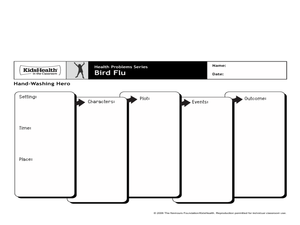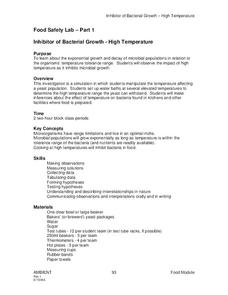Curated OER
Cover Your Mouth Please!
Second graders investigate how to slow the spread of germs from coughing and sneezing. In this illness prevention instructional activity, 2nd graders talk about why people cough and sneeze before telling about ways to prevent the spread...
Curated OER
Germs Experiment 2
Students express artistic ideas thru art glitter and science. Students experiment with the theory of how germs spread. Students summarize findings in an art format. Students work in groups to analyze data.
Curated OER
Germs and the Body
Fourth graders explore how germs affect the body and how to deal with them. They research internet websites to discover the detection and protection of germs. Students complete a worksheet to demonstrate germs.
Curated OER
Inquiry into Infectious Disease: It's a Germy World After All
Young scholars choose a question from a given list and develop an investigation about it. In this biology instructional activity, students analyze bacterial growth by carrying out a guided experiment. They present their findings in class.
Curated OER
Germs and the Importance of Washing Your Hands
Students determine the importance of hand washing through experiments. In this hand washing and germs lesson, students listen to a reading of Germs! Germs! Germs! by Bobbi Katz, and discuss what they learn about germs. They experiment by...
Curated OER
Breaking News: Shopping Carts Covered in Bacteria (5th March, 2011)
Students explore current events by completing several worksheet activities. For this bacteria infections lesson, students read a current news story of the germs associated with shopping carts and how people should protect themselves....
Nemours KidsHealth
Germs: Grades K-2
Students demonstrate knowledge about germs. For this health lesson, students investigate what germs are, how to protect the skin by comparing the skin to apple skins, and the proper hand washing technique for getting rid of germs....
Curated OER
Bird Flu
Students examine how germs are spread. In this bird flu instructional activity, students read articles containing information about the bird flu and how to prevent bird flu, washing hands and germs. Students discuss these...
Curated OER
Making Germ Monsters
Students explore germs. In this literacy and health instructional activity, students listen to the book Germs! Germs! Germs! by Bobbi Katz and discuss methods that prevent the spreading of germs. Students cut symmetrical shapes out of...
Curated OER
Washing Germs Away
Students investigate germs. In this cross curriculum health and biology lesson plan, students listen to Old Black Fly by Jim Aylesworth and identify ways in which flies spread germs. Students discuss hand washing during a visit by the...
Curated OER
The Case of the Classroom Cleanup
Students complete activities to learn about germs in their classroom and healthy habits. For this germs and health lesson, students participate in a classroom cleanup activity. Students draw germs on a poster of the classroom and...
Curated OER
Food Safety Lab
Students determine the optimal living conditions for yeast and apply these results to microbes in food. In this microbiology lab instructional activity, students observe the reaction of yeast to elevated temperatures. They relate these...
Curated OER
Germ Busting and Dusting
Students simulate germs on their hands with flour. In this germs lesson, students touch several surfaces to show how a sneeze spreads. Students discuss how to prevent the spread of germs.
Curated OER
Tag, You're Sick
Students play a game to model how the immune system works. In this health and wellness lesson, the teacher explains how the immune system works, then students play a game of tag trying to stay away from germs, viruses, and bacteria and...
Curated OER
Washing Hands
Students formulate questions about a germ book before it is read to them. In this washing hands lesson plan, the teacher gets glitter on each students hands that represents germs. Before the teacher reads a book about germs the students...
Curated OER
Health Education: Germs
Fourth graders take part in a germ simulation activity. In this personal health lesson plan, 4th graders summarize methods for preventing the spread of germs that cause communicable diseases.
Curated OER
How to Wash My Hands
In this sequencing the steps for washing hands worksheet, students color the pictures and write the numbers for each one in order. Students write four answers.
Curated OER
Dirty Hands Can Make You Sick
A word bank of "dirty words" are used to fill in the blanks of 9 questions. In this keeping healthy worksheet, students use a word bank to complete sentences. A good resource for young students.
Curated OER
Germs: Learning Not to Share
Young scholars have cinnamon sprinkled onto their hands and walk around the room touching objects within their reach. Students observe all of the objects containing cinnamon fingerprints to visualize where and how germs are spread.
Curated OER
Disease Prevention and HIV/AIDS Education
Young scholars discuss communicable and non-communicable diseases, and how germs travel from person to person through the air, on objects, in body fluids, and on animals and insects. They take a short quiz.
Curated OER
Germs Experiment
Young scholars observe how germs grow on three germ covered potato slices and one control slice. They study the scientific method, how germs form and the importance of hand washing.
Curated OER
Germs and Preventing Illness: An Inner and Outer
First graders looks at germs through a microscope and identify two that can make us sick. They compare their mouth before and after they brush their teeth and practice proper hand washing techniques. They study the impact of Edward...
Curated OER
Immune System: The Master of Self-Defense
Students examine the role of the immune system in the human body. They conduct a hand-washing experiment, answer questions while viewing videos, discuss key vocabulary, draw and label illustrations, and observe demonstrations and record...
Curated OER
What Did I Touch Today?
Young scholars investigate germs and how they travel. They graph the places in the classroom that have been touch by students to determine which five places have had the most contact. They write stories from a germ's point of view.

























